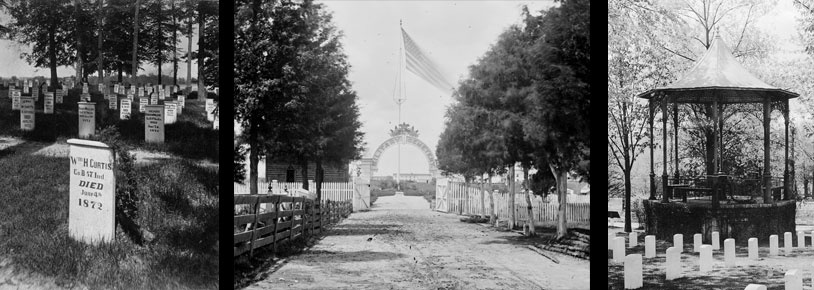

Civil War Era National Cemeteries: Honoring Those Who Served
Andersonville National Cemetery
Andersonville, Georgia
 |
Andersonville National Cemetery National Park Service |
Prior to the construction of Camp Sumter, the Confederacy held prisoners of war in Richmond, Virginia. With the city’s food supplies dwindling and citizens' increasing concern about the potential for a prison break, Confederate leaders chose to build a new prison at Andersonville. The tiny Georgia village featured a remote location, ample water supplies, and proximity to a railroad line. Slaves and Confederate soldiers began the prison’s construction in January 1864. The first prisoners, 500 in total, arrived a month later, prior to the prison’s completion.
The slaves and Confederate soldiers constructed a stockade of heavy upright timbers enclosing a field of approximately 16 acres. A “dead line,” delineated by a low wood railing, formed an inner perimeter. Guards were instructed to shoot any prisoners crossing the line to approach the wall.
Confederate Captain W. Sidney Winder designed the prison, which he felt could hold 10,000 prisoners. By June 1864, Andersonville held more than 26,000 prisoners. Work began to enlarge the stockade, adding 10 more acres, bringing the total size to 26.5 acres by July. In August, the number of prisoners jumped to its highest point, with more than 33,000 Union soldiers held at the stockade.
With growing numbers of prisoners and dwindling supplies, conditions in the camp rapidly deteriorated. Although Confederate guards provided meager rations of cornmeal and meat, initially prisoners were not provided utensils for cooking or eating. Rough shelters of branches and cloth provided inadequate shelter. Some prisoners were nearly naked because their clothing was so worn. The stockade’s water supply, a small stream running through the prison, quickly became polluted. The unsanitary conditions, compounded by disease and malnutrition, led to the death of more than 12,000 prisoners. Over 900 prisoners died each month. The dead, both Union prisoners and their Confederate guards, were laid in mass graves at a site 300 yards north of the stockade. Trenches three feet wide and 200 feet long accommodated hundreds of bodies, laid shoulder to shoulder.
Seven months after the prison took in its first inmates, Union General William T. Sherman captured Atlanta. Able-bodied inmates were transferred from Andersonville to prisons in Savannah and South Carolina. The most infirm and ill stayed at Andersonville, which remained in operation until April 1865.
The U.S. government appropriated the burial ground in July 1865, establishing the property as a national cemetery. A month later, the famous Civil War nurse Clara Barton surveyed the cemetery to identify and mark the graves of the Union dead. In 1868, Union soldiers temporarily buried in the local vicinity were reinterred at the Andersonville National Cemetery, increasing the number of Civil War graves to nearly 13,700.
1893 Site Plan of Andersonville National Cemetery. |
Today the Andersonville National Cemetery is surrounded by pine trees. A four-foot-tall brick wall, constructed in 1872, encloses the cemetery’s 27 acres. Two drives divide the property into four quadrants; crossing at a diamond-shaped intersection near the center of the property. The cemetery is divided into 17 sections. A majority of those who died while imprisoned at Andersonville are buried in sections E, F, H, J, and K.
A superintendent’s lodge, constructed in 1872, is located on the western edge of the property. The lodge was extensively modified during the 1930s with the addition of a kitchen and the complete demolition and reconstruction of the second floor. Opposite the lodge on the cemetery’s east side is a rostrum built in 1941. The stone structure, capped with a metal roof, serves as a speaking platform for ceremonies.
Between 1905 and 1916, nine Union states erected monuments honoring those who died while being held prisoner at Andersonville: Maine (1904), Pennsylvania (1905), Connecticut (1907), Illinois (1907), Indiana (1908), Iowa (1908), New Jersey (ca. 1910), New York (1914), and Minnesota (1916). The monuments, ranging in height between six and thirty-six feet, are constructed of a variety of materials and are adorned with statues and funereal symbols. More recently constructed monuments include the Georgia Monument, dedicated in 1976 to commemorate all American POWs, and a memorial to those held in German POW Camp Stalag 17B during World War II.
| Plan your visit |
The entrance for the Andersonville National Historic Site, which includes the Andersonville National Cemetery, is located on Georgia Rte. 49, approximately one mile north of the intersection of Rte. 49 and Georgia Rte. 228, in Andersonville, GA. Andersonville National Historic Site is a unit of the National Park System and is dedicated to preserving and interpreting the Confederate prison site while also educating visitors about the experiences and hardships of prisoners of war. Through exhibits and other interpretive tools, the National Prisoner of War Museum tells the story of Civil War era prisons and POWs, in addition to the sacrifices made by American POWs in World Wars I and II, the Korean War, and the Vietnam War. A brief history of the Andersonville prison and the cemetery is available on the History & Culture page of the National Historic Site website. The Confederate stockade at Andersonville is the subject of an online lesson plan, Andersonville: Prisoner of War Camp. The lesson plan provides additional information on prison camps in the South, the living conditions Union soldiers endured, and additional historic context. The lesson plan has been produced by the National Park Service’s Teaching with Historic Places program, which offers a series of online classroom-ready lesson plans on registered historic places. To learn more, visit the Teaching with Historic Places home page. |
